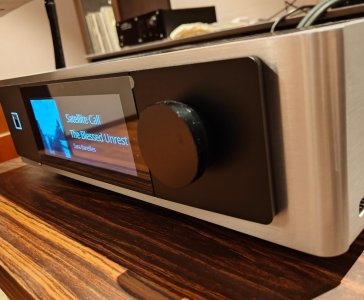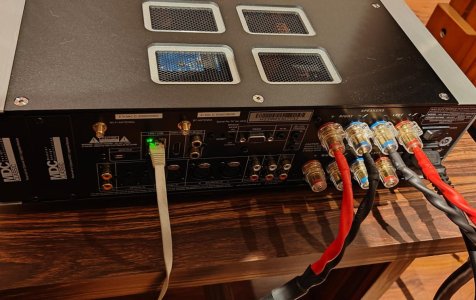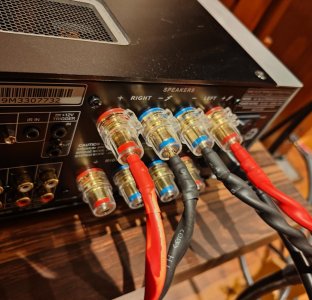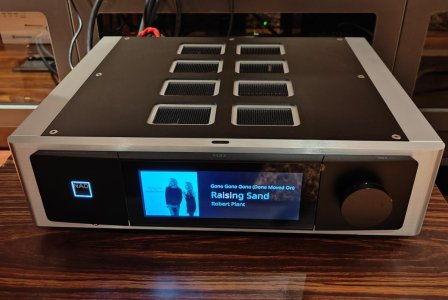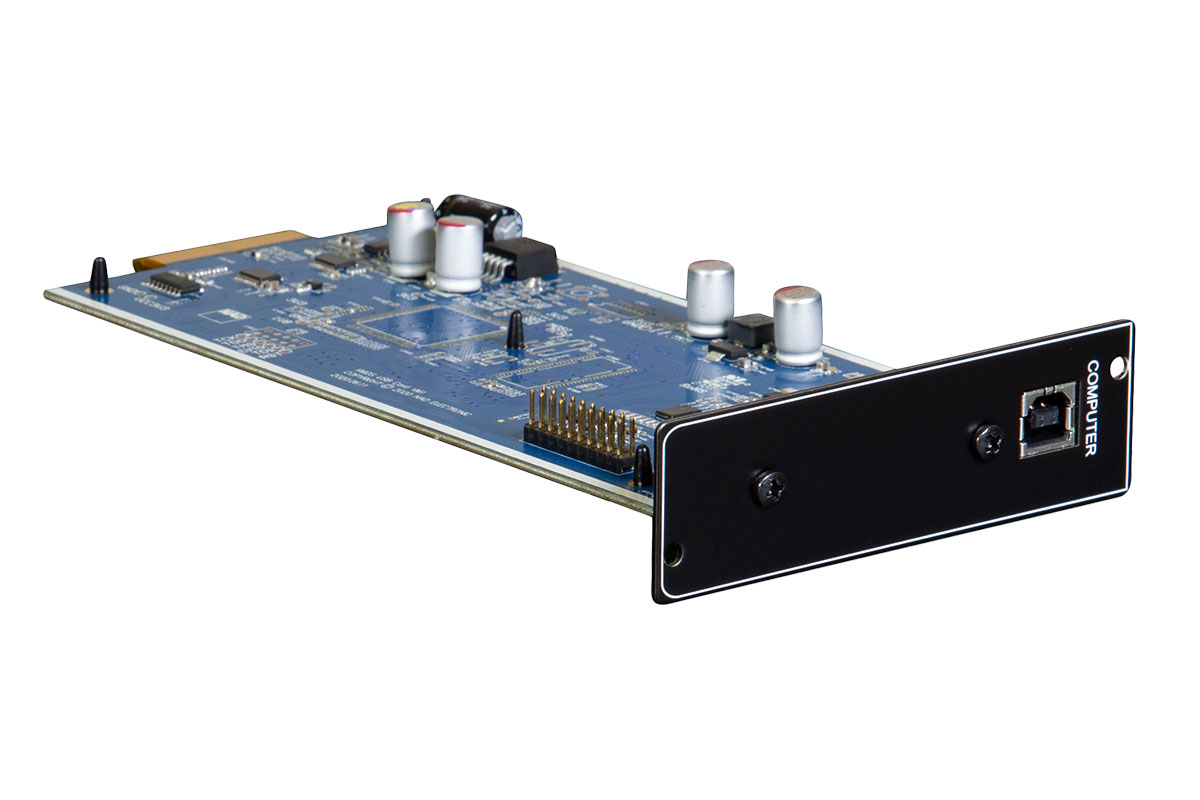reignofchaos
Well-Known Member
I recently had the pleasure of listening to the NAD M33 amplifier in my listening room. This was a demo unit loaned to me by Lenbrook India. Below is an unbiased review of the product - I have no commercial affiliations with anyone in the audio industry.
The Product:
The NAD M33 is an all-in-one convergence device. It consists of a BluOS based streamer, a high-quality DAC, a preamplifier and an amplifier in one box. This amp also contains a custom DSP engine that supports room correction via Dirac. The amp comes with a limited Dirac license which allows the user to adjust only the bass section up to 500 Hz by default. A separate full signal license needs to be purchased separately.
This amp outputs 200W/ch into 8 ohms and 380W/ch into 4 ohms. This amp is based on a custom version of the Purifi 1ET400A Class D modules (More on this later). NAD has a custom implementation of this design with their own switch mode power supply. The front-end DAC is based on the ESS 9028 Pro DAC chip. The preamplifier section is analog and supports a direct mode where signal purity is maintained and a DSP mode where various effects and tone controls can be applied.
Design and Functionality:
The front fascia of the amp consists of a huge touch screen that displays relevant information regarding media being played and other settings. The industrial design is beautiful with a black and silver scheme. The top of the amp has large vents covered by perforated metal.
One needs to download the BluOS app for complete control of most relevant functions of this amplifier. In the simplest scenario, if playing music off streaming sources only, the only things one needs to connect to play music are the speaker cables assuming wifi is available. However wired network is the recommended mode of operation and this review was done entirely with the amp connected via ethernet to my home network running on Ubiquiti switches and routers. The experience of starting the amp the first time, the device booting, connecting to the network and the app, then updating itself was entirely seamless and took no. more than 10-15 minutes. After that, all I had to do was login to Tidal/Qobuz within the BluOS UI and start streaming music.
While this amp is primarily intended for streaming music consumption due to the BluOS smarts, the amp also has a bunch of digital coaxial, toslink, RCA/XLR analog inputs and also a MM phono input. So a wide range of auxiliary devices may be connected to the device based on needs. For folks connecting a computer, a USB audio input would have been a nice addition. The amp also has a pair of RCA preamp outs to connect to external power amplifiers and also a pair of low level subwoofer outputs for connecting to active subwoofers. It is possible to internally set a crossover for the subwoofers and redirect frequencies below the crossover frequency to the subwoofer. I had success connecting a CD transport via coaxial, a subwoofer to the sub outputs and the supplied Dirac mic to the mic input for room measurements. I did try to measure my room using Dirac and tried building some filters based on the measurements. However as this was my first time and I'm inexperienced in this, the endeavor was entirely useless as I ended up making the amp sound worse with Dirac enabled. For the rest of the review, it is assumed that Dirac is not active.
System Setup:
For the purposes of this review, the primary speaker used for listening was a pair of ATC SCM19 bookshelves. These are low sensitivity speakers coming in at around 85dB and are known to be hard to drive. They need a whole load of power and current to move the mid-range super linear driver enough to produce good sound. The Purify 1ET400A modules in this amp had absolutely no trouble controlling this speaker perfectly and produced prodigious amounts of bass from the small bookshelf. These state-of-the-art modules designed by the maverick designer Bruno Putzeys are known to produce fantastic, smooth sound very unlike a typical Class D design. The designer is well known for producing ultra high-end products under the Mola Mola brand name. Lenbrook, the parent of NAD has acquired an architecture license for these purify modules which has allowed them to redesign them from what is available to the DIY market.
Sound:
NAD has done a stellar job with this amplifier - it is no signature of its own - it is dead neutral. There is absolutely no color of any sort imparted to the sound. You feed it with a tube DAC, it will sound like a tube, feed it with a solid state DAC, it will sound solid state. When run with its internal DAC - either via the BluOS module or via the SPDIF input, there is a hint of warmth and a very lively sound with clearly defined leading edges. There is a lot of detail - sometimes excessive but it is aways presented in a polite smooth way. The soundstage produced is wider than the speakers and incredibly deep. In fact, I'd say the internal DAC section is probably the best ESS DAC I've heard to date. It does not have the typical harshness associated with Chinese DACs that one associates as the ESS sound signature. It was quite a humbling experience for me who loves tube power amps and non-oversampling DACs that an ESS based DAC connected to a switching power supply and Class D modules can sound so uncolored and smooth with no typically distracting artifacts that are normally associated with both Class D and ESS. Every Class D amplifier I've encountered so far has either been grainy up top or loses control of the drivers and starts to sound muddy. The NAD has none of those issues - even at a very loud (read near 100dB) volume level, the amp never lost composure or started to sound distorted. Overall, I was exceptionally pleased with the wholesome sound delivered by this amp. One thing I’d like to say is that though the sound through both the internal BluOS module and DAC and via the analog inputs is exceptional, the MM phono stage built into the M33 is not super awesome. It is barely passable and if you have a mid- range or high-end TT+cartridge, you’d do well in getting a standalone phono stage and using the line inputs. A special mention must be made of the headphone output on the front panel – it is exceptional. It bested my DIY Sapphire headphone amp when driving both my Sennheiser HD650 and my Hifiman Sundara planar headphones.
Comparisons:
Since this is an all-in-one device, and I only possess separates, I compared a particular section of the device with a particular component. I drove both the ATC bookshelves mentioned above, a pair of Dynaudio Emit 10 bookshelves and a pair of horn loaded Blumenhofer Big Fun 17 speakers with the NAD M33. It worked well with all the above. If I were to pick a particular pairing, I preferred the ATC the most in this and used that for most of the review. There was a slight synergy issue with the Blumenhofer which made the speaker sound a bit colder but then it is an idiosyncratic speaker that is a bit fussy about amplifier matching. The Dyns were driven well but since they are small, they had dynamic constraints, and I was worried of overdriving them beyond their limits. I do not expect anyone to have issues driving any speaker – big or small with this amplifier. It has ample power reserves.
When comparing the power amp section of this amp with my reference 325W/ch O&B monoblocks, I found that the NAD drove the speakers harder but in difficult passages were less dynamic than my reference amps. For example, in the helicopter pan sound present in “Another Brick in the Wall” - Pink Floyd, The Wall album, the O&Bs held a firmer grip on the speakers and the impact of each of the blades whirring was significantly harder. However, in bass heavy tracks like “Teardrop” from Massive Attack, the NAD dug deeper. When listening to male vocals like Mark Knopfler’s voice in the track “Lights of Taormina” from the “Tracker” album, the voice was a wee bit more fleshed out on the O&B compared to the NAD. The song “Famous Blue Raincoat” from the same named album by Jennifer Warnes is a great test of both female vocals where the NAD excelled and also a test of high frequency extension and air when the saxophone plays. The NAD had slightly better extension at the top compared to my O&B mono amps. One area where the monos were better was in sound staging – the stage was wider and deeper and there was more air around each of the instruments in space.
For comparing the DAC section of the M33 to a dedicated DAC, I chose NAD’s own NAD M51 Direct Digital DAC connected via coaxial to a CD transport. The internal DAC of the M33 completely outclassed the M51 standalone DAC in resolution, dynamics and tone when using the same CD transport. The M51 standalone DAC sounded bloated and muffled in comparison. I was blown away that a highly regarded top end standalone DAC from the previous generation from the same company was so badly thrashed by the internal DAC section of this integrated amplifier. Impressed by this, I then connected my AMR DP-777 DAC/Preamp to the analog inputs of the M33 and this made an immediate impression. This was the bet sound I got out of this amplifier. It was full, smooth and had an ethereal quality to it that gave me even more insight into the recording. However comparing the internal dac to the AMR
Conclusion:
The NAD M33 is a fantastic all-in-one convergence device where you get more than the sum of parts. For the asking price of roughly 475000 in India, you get a high-quality streamer, a really great DAC, an analog preamp, a DSP with room correction and finally a no compromise 200W/ch Class D power amplifier in one beautifully designed chassis that is great to use thanks to a large touchscreen in the front and an incredibly well polished app. It sounds fantastic standalone or when connected to external components. Each of its internal stages stands up to scrutiny and matches or sometimes handily beats standalone components. If you are building a system from scratch in the sub 10L INR range, this amp is a no brainer – you will get everything you need in one box and you just have to add speakers. The equation becomes much muddier when you are invested in separates like me. In that case only a comparison will tell you if this amp satisfies you and whether it makes sense to have a fresh start. If you are downsizing your system due to space, this is one amp that must be an essential audition. I give the NAD M33 a very high recommendation – especially considering that it is sold at a very fair price in India compared to the international market.
Associated Gear:
ATC SCM19 Loudspeakers + PSB Sub 250 subwoofer
Dynaudio Emit 10 loudspeakers
Blumenhofer Big Fun17 loudspeakers
O&B SSMB1400 monoblock amplifiers
Conrad Johnson Premier 11a Tube amplifier
AMR DP 777 DAC/Preamp
Clearaudio Concept Turntable
The Product:
The NAD M33 is an all-in-one convergence device. It consists of a BluOS based streamer, a high-quality DAC, a preamplifier and an amplifier in one box. This amp also contains a custom DSP engine that supports room correction via Dirac. The amp comes with a limited Dirac license which allows the user to adjust only the bass section up to 500 Hz by default. A separate full signal license needs to be purchased separately.
This amp outputs 200W/ch into 8 ohms and 380W/ch into 4 ohms. This amp is based on a custom version of the Purifi 1ET400A Class D modules (More on this later). NAD has a custom implementation of this design with their own switch mode power supply. The front-end DAC is based on the ESS 9028 Pro DAC chip. The preamplifier section is analog and supports a direct mode where signal purity is maintained and a DSP mode where various effects and tone controls can be applied.
Design and Functionality:
The front fascia of the amp consists of a huge touch screen that displays relevant information regarding media being played and other settings. The industrial design is beautiful with a black and silver scheme. The top of the amp has large vents covered by perforated metal.
One needs to download the BluOS app for complete control of most relevant functions of this amplifier. In the simplest scenario, if playing music off streaming sources only, the only things one needs to connect to play music are the speaker cables assuming wifi is available. However wired network is the recommended mode of operation and this review was done entirely with the amp connected via ethernet to my home network running on Ubiquiti switches and routers. The experience of starting the amp the first time, the device booting, connecting to the network and the app, then updating itself was entirely seamless and took no. more than 10-15 minutes. After that, all I had to do was login to Tidal/Qobuz within the BluOS UI and start streaming music.
While this amp is primarily intended for streaming music consumption due to the BluOS smarts, the amp also has a bunch of digital coaxial, toslink, RCA/XLR analog inputs and also a MM phono input. So a wide range of auxiliary devices may be connected to the device based on needs. For folks connecting a computer, a USB audio input would have been a nice addition. The amp also has a pair of RCA preamp outs to connect to external power amplifiers and also a pair of low level subwoofer outputs for connecting to active subwoofers. It is possible to internally set a crossover for the subwoofers and redirect frequencies below the crossover frequency to the subwoofer. I had success connecting a CD transport via coaxial, a subwoofer to the sub outputs and the supplied Dirac mic to the mic input for room measurements. I did try to measure my room using Dirac and tried building some filters based on the measurements. However as this was my first time and I'm inexperienced in this, the endeavor was entirely useless as I ended up making the amp sound worse with Dirac enabled. For the rest of the review, it is assumed that Dirac is not active.
System Setup:
For the purposes of this review, the primary speaker used for listening was a pair of ATC SCM19 bookshelves. These are low sensitivity speakers coming in at around 85dB and are known to be hard to drive. They need a whole load of power and current to move the mid-range super linear driver enough to produce good sound. The Purify 1ET400A modules in this amp had absolutely no trouble controlling this speaker perfectly and produced prodigious amounts of bass from the small bookshelf. These state-of-the-art modules designed by the maverick designer Bruno Putzeys are known to produce fantastic, smooth sound very unlike a typical Class D design. The designer is well known for producing ultra high-end products under the Mola Mola brand name. Lenbrook, the parent of NAD has acquired an architecture license for these purify modules which has allowed them to redesign them from what is available to the DIY market.
Sound:
NAD has done a stellar job with this amplifier - it is no signature of its own - it is dead neutral. There is absolutely no color of any sort imparted to the sound. You feed it with a tube DAC, it will sound like a tube, feed it with a solid state DAC, it will sound solid state. When run with its internal DAC - either via the BluOS module or via the SPDIF input, there is a hint of warmth and a very lively sound with clearly defined leading edges. There is a lot of detail - sometimes excessive but it is aways presented in a polite smooth way. The soundstage produced is wider than the speakers and incredibly deep. In fact, I'd say the internal DAC section is probably the best ESS DAC I've heard to date. It does not have the typical harshness associated with Chinese DACs that one associates as the ESS sound signature. It was quite a humbling experience for me who loves tube power amps and non-oversampling DACs that an ESS based DAC connected to a switching power supply and Class D modules can sound so uncolored and smooth with no typically distracting artifacts that are normally associated with both Class D and ESS. Every Class D amplifier I've encountered so far has either been grainy up top or loses control of the drivers and starts to sound muddy. The NAD has none of those issues - even at a very loud (read near 100dB) volume level, the amp never lost composure or started to sound distorted. Overall, I was exceptionally pleased with the wholesome sound delivered by this amp. One thing I’d like to say is that though the sound through both the internal BluOS module and DAC and via the analog inputs is exceptional, the MM phono stage built into the M33 is not super awesome. It is barely passable and if you have a mid- range or high-end TT+cartridge, you’d do well in getting a standalone phono stage and using the line inputs. A special mention must be made of the headphone output on the front panel – it is exceptional. It bested my DIY Sapphire headphone amp when driving both my Sennheiser HD650 and my Hifiman Sundara planar headphones.
Comparisons:
Since this is an all-in-one device, and I only possess separates, I compared a particular section of the device with a particular component. I drove both the ATC bookshelves mentioned above, a pair of Dynaudio Emit 10 bookshelves and a pair of horn loaded Blumenhofer Big Fun 17 speakers with the NAD M33. It worked well with all the above. If I were to pick a particular pairing, I preferred the ATC the most in this and used that for most of the review. There was a slight synergy issue with the Blumenhofer which made the speaker sound a bit colder but then it is an idiosyncratic speaker that is a bit fussy about amplifier matching. The Dyns were driven well but since they are small, they had dynamic constraints, and I was worried of overdriving them beyond their limits. I do not expect anyone to have issues driving any speaker – big or small with this amplifier. It has ample power reserves.
When comparing the power amp section of this amp with my reference 325W/ch O&B monoblocks, I found that the NAD drove the speakers harder but in difficult passages were less dynamic than my reference amps. For example, in the helicopter pan sound present in “Another Brick in the Wall” - Pink Floyd, The Wall album, the O&Bs held a firmer grip on the speakers and the impact of each of the blades whirring was significantly harder. However, in bass heavy tracks like “Teardrop” from Massive Attack, the NAD dug deeper. When listening to male vocals like Mark Knopfler’s voice in the track “Lights of Taormina” from the “Tracker” album, the voice was a wee bit more fleshed out on the O&B compared to the NAD. The song “Famous Blue Raincoat” from the same named album by Jennifer Warnes is a great test of both female vocals where the NAD excelled and also a test of high frequency extension and air when the saxophone plays. The NAD had slightly better extension at the top compared to my O&B mono amps. One area where the monos were better was in sound staging – the stage was wider and deeper and there was more air around each of the instruments in space.
For comparing the DAC section of the M33 to a dedicated DAC, I chose NAD’s own NAD M51 Direct Digital DAC connected via coaxial to a CD transport. The internal DAC of the M33 completely outclassed the M51 standalone DAC in resolution, dynamics and tone when using the same CD transport. The M51 standalone DAC sounded bloated and muffled in comparison. I was blown away that a highly regarded top end standalone DAC from the previous generation from the same company was so badly thrashed by the internal DAC section of this integrated amplifier. Impressed by this, I then connected my AMR DP-777 DAC/Preamp to the analog inputs of the M33 and this made an immediate impression. This was the bet sound I got out of this amplifier. It was full, smooth and had an ethereal quality to it that gave me even more insight into the recording. However comparing the internal dac to the AMR
Conclusion:
The NAD M33 is a fantastic all-in-one convergence device where you get more than the sum of parts. For the asking price of roughly 475000 in India, you get a high-quality streamer, a really great DAC, an analog preamp, a DSP with room correction and finally a no compromise 200W/ch Class D power amplifier in one beautifully designed chassis that is great to use thanks to a large touchscreen in the front and an incredibly well polished app. It sounds fantastic standalone or when connected to external components. Each of its internal stages stands up to scrutiny and matches or sometimes handily beats standalone components. If you are building a system from scratch in the sub 10L INR range, this amp is a no brainer – you will get everything you need in one box and you just have to add speakers. The equation becomes much muddier when you are invested in separates like me. In that case only a comparison will tell you if this amp satisfies you and whether it makes sense to have a fresh start. If you are downsizing your system due to space, this is one amp that must be an essential audition. I give the NAD M33 a very high recommendation – especially considering that it is sold at a very fair price in India compared to the international market.
Associated Gear:
ATC SCM19 Loudspeakers + PSB Sub 250 subwoofer
Dynaudio Emit 10 loudspeakers
Blumenhofer Big Fun17 loudspeakers
O&B SSMB1400 monoblock amplifiers
Conrad Johnson Premier 11a Tube amplifier
AMR DP 777 DAC/Preamp
Clearaudio Concept Turntable


